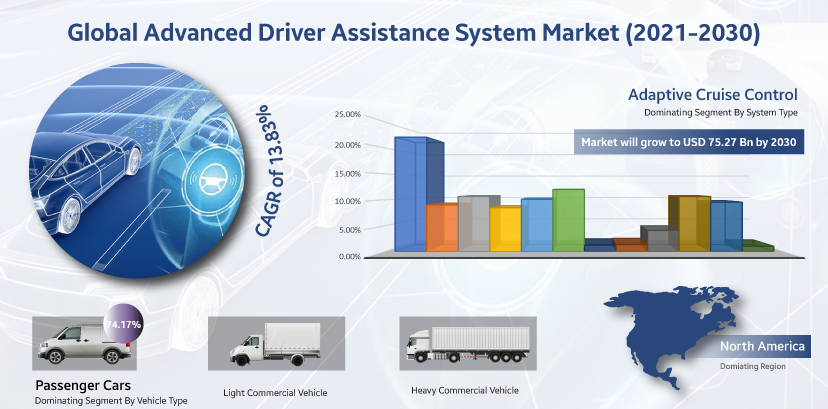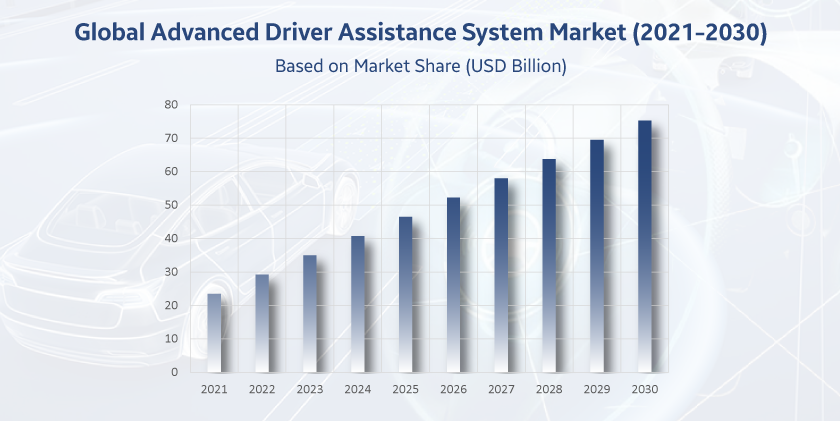The global advanced driver assistance systems (ADAS) market will witness a robust CAGR of 13.83%, valued at $23.44 billion (€23.98 billion) in 2021, expected to appreciate and reach $75.23 billion (€76.97 billion) by 2030, confirms Strategic Market Research. ADAS (Advanced Driver Assistance Systems) are technologies and electronic systems in a vehicle to assist the driver. ADAS utilises the sensors that are present inside the vehicle, such as a camera and a radar, to have a vigil on the outside world.
ADAS provides pivotal information like the level of congestion present on the roads, updates on traffic, blockage, and closure of roads ahead so that the driver gets alerted beforehand. This system also measures the driver’s distraction and level of fatigue of the driver, thereby suggesting the precautions that need to be taken. ADAS can take control from the driver if it perceives any kind of threat or if any difficult task needs to be performed like (parking or overtaking). After perceiving the outside world, it divulges the information to the driver or undertakes automatic action depending on what it has perceived. Driver assistance is a technology that helps make motor vehicles travel much safer by improving, automating, or adapting most of the tasks involved in driving.
ADAS improves vehicle and road safety by utilising a secure human-machine interaction. The system uses automated technology, including sensors, cameras, and software, to detect and respond to surrounding impediments or driver mistakes. Depending on the components implemented in the automobile, ADAS leads to varying levels of autonomous driving. ADAS could be instrumental in reducing driver accidents, which have increased in recent years. ADAS is a new technology, and not many vehicles have this system installed in them as it is still at a nascent stage. A study showed that only 10% of the 1 billion cars worldwide had ADAS installed in them. Around 33% of new cars that are now sold in major markets such as Europe, China, Japan, and the US have ADAS features, but it will be several years before they are installed in at least half of all cars on the world’s roads.

ADAS began with the invention of modern cruise control in 1948. In the 1950s, anti-lock brakes were introduced and used in different vehicles. By the year 2000, original equipment manufacturers have been researching newer developments of the modern cruise control system in their vehicles, like laser and electronic-based cruise control. With the introduction of Google’s Self-Driving Car in 2010 and Mercedes’ Bertha in 2013, ADAS has been widely used in driverless cars.
ADAS is designed to avert crashes by alerting drivers to prospective risks or taking over control of the vehicle to avoid such danger. According to a study, the Electronic Stability Programme (ESP), a type of ADAS, reduced the number and severity of loss-of-control automobile accidents by 22.1%. On wet roads, the ESP had an accident reduction effectiveness of 31.5%, while on roads covered with snow and ice, it had a reduction effectiveness of 38.2%. Automated illumination, adaptive cruise control, and pedestrian collision avoidance mitigation (PCAM) are navigational technologies that notify drivers of possible hazards such as cars in blind areas, lane departures, and more.
Key industry drivers stringent vehicular safety regulations, growing disposable income
The rising implementation and enforcement of stringent vehicular safety regulations have caused many automobile manufacturers to install ADAS into many of their manufactured vehicles, which causes market growth. The increase in the number of vehicular safety regulations can be attributed to the rise in traffic accidents worldwide. According to the NHTSA (National Highway Traffic Safety Administration) Department of Transportation, 42,915 fatalities were estimated in 2021, a 10.5% increase from 38,824 fatalities in 2020. 16% of these fatalities were due to multi-vehicle crashes, and those happened on urban roadways.
The increase in disposable income among the world’s population has driven the growth of the advanced driver assistance systems market. Disposable income is left over post deduction of taxes and other governmental charges, which can be spent or saved per the person’s wishes. With a high disposable income, customers will prefer cars with advanced technology, thereby fostering market growth. According to the BEA (Bureau of Economic Analysis), the monthly change (in percentage) of disposable personal income in the USA was 0.3% in April 2022, a great increase from -15.1% change in disposable personal income in April 2021.
Restraints lack of required infrastructure
- For effective operation, ADAS requires basic infrastructure such as well-organised roads, lane marking, and GPS availability. Cost considerations, Poor infrastructure outside of urban areas, and lack of driving training or discipline limit the advanced driver assistance systems (ADAS) market growth in developing countries.
Opportunities new technology, new vehicular models, new markets
- The new technology and vehicular infrastructure developed by various companies to install in their vehicles could foster the advanced driver assistance systems market growth. Technology like blind spot detection, automatic emergency braking, traffic sign, lane departure warning, lane assist (operates above 37 mph), pedestrian detection, self-driving car, adaptive cruise control, adaptive light control, automatic parking, autonomous valet parking, navigation system, crosswind stabilisation, driver monitoring system and emergency driver assistant could help more drivers in driving efficiently while allowing manufacturers to confirm with growing traffic safety regulations. These systems have high efficiency, which helps in reducing the number of traffic accidents. According to the IIHS (Insurance Institute for Highway Safety), blind-spot monitoring reduces lane-changing accidents by 14%. The IIHS also reported that the system reduced injuries due to lane-changing crashes by 23%.
- Newer vehicles are being manufactured by various companies to improve vehicle-ADAS compatibility, increasing the demand for ADAS systems and worldwide market growth. Autonomous cars, self-driving cars, and robo-cars requiring minimum human intervention in driving are manufactured worldwide. Their sales are expected to increase exponentially in the near future, which drives the demand for the ADAS system and the market growth. According to a study, the production of robo-cars is expected to reach about 800 thousand units in 2030, an 87.5% increase from 100 thousand robo-cars to be produced in 2023.
- Expanding ADAS to newer markets could help improve the awareness of ADAS in these markets. The expansion to Europe and China by region, and the commercial vehicle ADAS and the electric vehicles by vehicle can help to grow the global market. According to SMMT and JATO dynamics, nearly 80% of all new cars are now offered in the United Kingdom with at least one self-activating safety system, either as a standard or an optional extra. Nearly 1.8 million vehicles are available in a year with collision warning systems.

Comment on this article below or via Twitter: @IoTNow_OR @jcIoTnow







